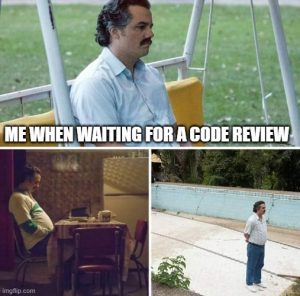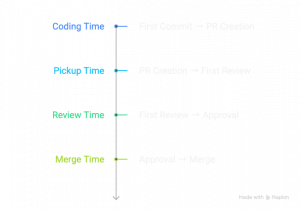Ever pushed a PR, feeling pretty good about it, then watched it sit there? And sit there. And sit there. Days go by….

By the time someone finally reviews it, you’ve completely lost context and a merge conflict monster has moved in.
Sound familiar? You’re not alone. This lag is a direct hit to your team’s velocity, and it’s a symptom of a long PR cycle time. This isn’t some fuzzy metric for managers; it’s one of the most powerful levers you have for improving developer productivity and, honestly, making work feel a lot less frustrating.
We’re going to break down how to shorten that cycle without cutting corners on quality. It’s about working smarter, not just faster.
Deconstructing the PR Cycle: The Four Acts
Your PR’s journey from a handful of commits to a `main` branch merge isn’t one monolithic block of time. It’s a four-act play. If you want to speed things up, you first have to understand where the time is actually going.

Think of it like this:
- Act 1: Coding Time (First Commit → PR Creation). How long it takes you to write the code. This is a huge topic on its own, but for our purposes, it’s the input to the cycle we want to optimize.
- Act 2: Pickup Time (PR Creation → First Review). The “waiting” phase. This is often the biggest and most painful bottleneck. A long pickup time means your PR is sitting idle, waiting for a teammate to even look at it.
- Act 3: Review Time (First Review → Approval). The back-and-forth. This is where feedback happens, changes are requested, and new commits are pushed. It can drag on if feedback is unclear or the PR is too large.
- Act 4: Merge Time (Approval → Merge). The final step. This should be quick, but can be derailed by failed CI checks, merge conflicts, or a manual deploy process.
Most teams just feel “slow” without knowing why. But when you break it down, you can see the problem clearly. A long Pickup Time is a team availability problem. A long Review Time might be a PR size or feedback quality problem. A long Merge Time is a process or CI problem.
Measuring Your PR Cycle Time
You can’t fix what you can’t measure. Before you change anything, you need a baseline. Tools like GitHub Insights, LinearB, or Velocity can automate this for you, but you can even get a rough idea by manually checking a few recent PRs.
Look at the timestamps. When was the PR opened? When did the first comment appear? When was it approved? When was it merged?
Once you have a rough idea of your average time for each stage, you’ll know exactly where to focus your energy.
Strategies to Shrink Your Cycle Time
Alright, let’s get into the good stuff. Improving PR cycle time is a team sport. It requires a bit of discipline from the author, the reviewer, and the team as a whole.
For Authors: Set Your Reviewer Up for Success
As the author, your job is to make the reviewer’s job as easy as humanly possible. An easy-to-review PR is a fast-to-review PR.
- Make PRs small and focused. This is the golden rule. No one wants to review a 2,000-line monster that touches ten files. It’s cognitively overwhelming. A small PR (under 200-300 lines) focused on a single logical change is easier to understand, less risky, and gets reviewed way faster. If you have a huge feature, break it down into a stack of smaller PRs.
- Write a killer description. Don’t just dump a link to a Jira ticket. Your description is your pitch. What is the problem? How did you solve it? Is there anything specific the reviewer should look at? Add screenshots or a quick Loom video for UI changes. A great description turns a 30-minute review into a 5-minute one.
- Review your own code first. Seriously. Before you request a review, do a pass on your own PR. Read every line of the diff. You’ll be amazed at the number of typos, forgotten `console.log`s, or simple logic errors you catch. This saves everyone a round of back-and-forth.
For Reviewers: Be the Teammate You Want to Have
Your role as a reviewer isn’t to be a gatekeeper; it’s to be a collaborator who helps unblock your teammate.
- Prioritize reviews. Don’t let PRs pile up. A PR waiting for review is blocked work. Some of the best teams have a simple rule: if you’re not deep in focus mode, check for open PRs first. A team Service Level Agreement (SLA), like “first response within 4 hours,” can work wonders here. It’s not a hard rule, but a shared goal.
- Give actionable, constructive feedback. The goal is to improve the code, not to prove you’re the smartest person in the room. Instead of “This is bad,” try “What do you think about extracting this into a separate function for clarity?” Use GitHub’s “suggestion” feature for small fixes. Be clear, be kind, and focus on the important stuff, not just stylistic nitpicks (that’s what linters are for).
- Approve or request changes. Don’t leave a PR in limbo with a vague comment like “Looks interesting…” If it’s good to go, approve it. If it needs work, explicitly request changes and be clear about what’s required to get it to an approved state.
For the Team and Process: Build Guardrails, Not Gates
Individual habits are great, but a well-designed process scales that effort across the whole team.
- Automate the boring stuff. Your CI/CD pipeline is your best friend. Linters, formatters, and automated tests should be non-negotiable. Let the robots catch style issues, syntax errors, and regressions. This frees up human reviewers to focus on what matters: architecture, logic, and readability.
- Use a smart branching strategy. Long-lived feature branches are where PRs go to die. They accumulate merge conflicts and drift further and further from `main`. Encourage short-lived branches that are merged within a day or two. This naturally forces smaller, more frequent PRs.
- Encourage collaboration over confrontation. Is a PR getting stuck in an endless comment thread? Hop on a quick call. Five minutes of conversation can solve what takes an hour of typing. For really complex changes, consider pair programming. The fastest review cycle is one that doesn’t have to happen because you built it together.
The Payoff is Huge
This isn’t just about shaving a few hours off a metric. Shortening your PR cycle time has a ripple effect across the entire team.
You deliver value to users faster. You reduce the mental overhead of context switching. You improve code quality because feedback is timely and relevant. And maybe most importantly, you boost team morale. Nothing kills momentum like watching your work get stuck in procedural limbo.
It’s about creating a culture of momentum, collaboration, and continuous improvement. And it all starts with that one little PR.



